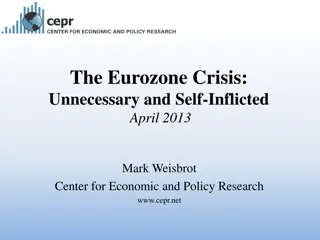Agrarian Crisis, Distress, Unrest; Peasant Movements & Suicide
Agrarian crisis in India is deepening, leading to distress among farmers and sparking peasant movements. Factors such as climate dependence, land loss, and lack of government support are exacerbating the situation. Farmer suicides are on the rise due to massive indebtedness. The impacts are far-reaching, affecting food supply, poverty, employment, and more. Addressing the root causes, like poor policy planning and dwindling farm sizes, is crucial to alleviate the crisis.
Download Presentation

Please find below an Image/Link to download the presentation.
The content on the website is provided AS IS for your information and personal use only. It may not be sold, licensed, or shared on other websites without obtaining consent from the author.If you encounter any issues during the download, it is possible that the publisher has removed the file from their server.
You are allowed to download the files provided on this website for personal or commercial use, subject to the condition that they are used lawfully. All files are the property of their respective owners.
The content on the website is provided AS IS for your information and personal use only. It may not be sold, licensed, or shared on other websites without obtaining consent from the author.
E N D
Presentation Transcript
Agrarian Crisis, Distress, Unrest; Peasant Movements & Suicide Dr. S. Mehdi Abbas Zaidi Associate Professor Department of Sociology Shia P.G. College, Lucknow E-mail - mehdi.abbas92@gmail.com Contact No. - +91-9839287412
Agrarian Crisis Agrarian crises mean the sharpening and explosion of the specific contradiction of reproduction of capital in agriculture In the opinion of Prabhat Patnaik, this crisis in Indian agriculture is unparalleled since independence and reminiscent only of the agrarian crisis of pre-war and war days . According to Sahai, the most tragic face of India s agrarian crisis is seen in the increasing number of farmer suicides.
Continuum Farmers suicides are no longer limited to the drought and poverty stricken areas of the country but because of their massive indebtedness. Agrarian crisis would be affecting a majority of the people in India and the economy as a whole in the long run. And therefore, it can be argued that the crisis in agriculture is a crisis of the country as a whole.
Factors Dependence on rainfall and climate Liberal import of agricultural products Reduction in agricultural subsidies Lack of easy credit to agriculture and dependence on money lenders Decline in government investment in the agricultural sector Conversion of agricultural land for alternative uses
Impacts It has adverse effects on: food supply, prices of foodgrains, cost of living, health and nutrition, poverty, employment, labour market, land loss from agriculture, and foreign exchange earnings.
Agrarian Distress Agrarian distress is mainly in terms of low agricultural prices and, consequently, poor farm incomes. Agrarian distress in contemporary India is not confined to the pockets of backwardness; even the regions having a high degree of commercial agriculture, using relatively better technology and having a relatively diversified cropping pattern have reported high indebtedness and distress of various kinds.
Reasons Poor policy and Planning Absence of direct measure to promote farmers welfare Declining average size of farm holdings Dependence on rainfall and climate Collapsing farm prices Lack of easy credit Lack of Mechanisation Profiteering by middlemen
Impacts The factors have resulted in low income for farmers which is evident from the incidence of poverty among farm households. The low and highly fluctuating farm income is causing a detrimental effect on the interest in farming and farm investments and is also forcing more and more cultivators, particularly younger age group, to leave farming. The country also witnessed a sharp increase in the number of farmers suicides in the last decades. This can cause an adverse effect on the future of food security and the state of agriculture in the country.
Agrarian Unrest The trend of agrarian unrest in India can be traced to the period of British rule when the nationalist mass movements took place. During the post-independence period, agrarian unrest of various types have taken place, ranging from the legendary Telengana movement and the PEPSU tenant movement to the Naxalite movement. Inequality in living standards caused unrest among the farmers and they tried to solve this problem through rebellion and movements.
Peasant Movements Peasant movement is a social movement involved with the agricultural policy, which claims peasants rights. Peasant movements were usually the result of stresses in the feudal and semi-feudal societies, and resulted in violent uprisings. Recent movements are usually much less violent, and their demands are centered on better prices for agricultural produce, better wages and working conditions for the agricultural laborers, and increasing the agricultural production.
Continuum Anthony Pereira, has defined a peasant movement as a "social movement made up of peasants (small landholders or farm workers on large farms), usually inspired by the goal of improving the situation of peasants in a nation or territory". Peasant movements are discussed in three categories: Pre-indepence Post-independence Contemporary
Pre-independence Peasant Movements Peasant movement in India arose during the British colonial period, when economic policies characterized in the ruin of traditional handicrafts leading to change of ownership, overcrowding of land, massive debt and impoverishment of peasantry. The Kisan Sabha movement started in Bihar under the leadership of Swami Sahajanand Saraswati, who formed the Bihar Provincial Kisan Sabha (BPKS) in 1929 to mobilise peasant grievances against the zamindari attacks on their occupancy rights.
Continuum All these radical developments on the peasant front culminated in the formation of the All India Kisan Sabha (AIKS) at the Lucknow session of the Indian National Congress in April 1936. The movement was increasingly dominated by Socialists and Communists.
Champaran Satyagraha (1917) Gandhiji lead the Champaran (Bihar) and Kheda (Gujarat) peasant struggles. The peasant movement of Champaran was launched in 1917-1918. The main aim was to create awakening among the peasantry against the European planters. These planters exploited the peasants without providing them adequate remuneration for their labor.
Kheda Peasant Struggle (1919) The peasantry of Kheda consisted mainly of Patidars who were known for their skills in agriculture. The Patidars were well-educated. Kheda is situated in the central part of Gujarat and was quite fertile for the cultivation of tobacco and cotton crops. The government increased the tax, which was not acceptable to the peasants. It was lead by Gandhiji, Sardar Vallabhbhai Patel, N.M. Joshi.
Bardoli Movement (1925) In the year 1925, the taluka of Bardoli suffered from heavy floods and severe famine which affected the crops very badly. This situation led the farmers to face great financial troubles. The Government refused to reduce the tax rate. The farmers were in a very pitiable state whereby they barely had anything enough to pay the tax, so, the farmers of Bardoli refused to pay the taxes.
Moplah Rebellion (1921) The Moplahs worked as small agriculturists who were the tenants of the big landlords. These landlords belonged to the high- caste Hindus. The Moplahs acquired the status of warriors by adopting the traditional ways of Nayars. The Moplah Peasant Movement started in August 1921. The government officials in alliance with the Hindu landlords oppressed the Moplah peasants. Most of their grievances were related to security of tenure, high rents, renewal fees, and other unfair exactions of the landlords.
Post-Independence Peasant Movements The Post-independent India saw broadly two kinds of peasant or farmers struggles in the recent past. Peasant movements led by Marxist and Socialists- such as: Telangana Movement (1946 51), Tebagha movement (1946 1949), Kagodu Satyagraha (1951), and Naxalbari Movement (1967). Farmers movement led by rich farmers in Uttar Pradesh, Karnataka, Maharashtra, Punjab and Gujarat.
Telangana Movement (1946-51) This movement was started against the Nizam of Hyderabad. The agrarian structure followed the feudal system at this time. The main commercial crops of the Telangana region were groundnut, tobacco, and castor seed, which were cultivated by the landowning Brahmins. the Brahmins, Marwaris, Muslims, and Vaisyas showed interest in gaining and acquiring the lands.
Continuum This resulted in sliding down of the status of the peasant proprietors to that of tenants at will sharecroppers and landless laborers. The cultivators were oppressed and exploited by these intermediaries who were appointed by the Nizam. The Nizam provided the irrigation facilities, most of these facilities were utilized by the big farmers only. The agricultural economy also underwent many changes; it was transformed more into a market economy than a subsistent one.
Continuum Such change did not improve the status of the tenants and sharecroppers. The Communist Party of India initiated the Telangana Peasant struggle. The Communist Party started working in the Telangana region from 1936. The prices of food and other commodities increased. The year 1946 proved to be a crisis time for both the tenants and the sharecroppers.
Continuum This year provided all the opportunities for launching a peasant struggle. The Indian army marched into the state of Hyderabad on 13 September 1948. The police action taken by the newly framed Central Government was quick in putting down the peasant movement.
Tebhaga Movement (1946- 49) It was a sharecropper s movement, which demanded two-thirds for themselves and one-third for the landlord. The crop sharing system at that time was known as barga, adhi, bhagi, etc., and the sharecroppers were called as bargadars or adhiars. There were two reasons why this action led to the insurrection on the part of the sharecroppers. First, they demanded that the sharing of the produce into half was not justified.
Continuum Secondly, the tenants were required to store their grains at the granary of the landlord and had to share the straw and other by products of the grains on half- sharing basis. The Berigal Provincial Krishak Sabha organized the movement of Tebhaga. The movement spread across the 19 districts of Bengal. The landlords refused to accept the demands of the tenants and called the police.
Continuum The police arrested the tenants and many of them were put behind the bars. This action made the tenants more furious and they started a new slogan to abolish the whole Zamindari system. In early 1947, such developments led the government to introduce a bill in the Legislative Assembly. The bill proposed to reform the bhagi system of the country, which caused the agrarian unrest.
Continuum The government could not enact the bill into a law. The Tebhaga movement, to an extent, was successful, as it has been estimated that about 40 per cent of the sharecropping peasants were granted the Tebhaga right by the landowners themselves.
Naxalbari Movement (1967) It is a violent peasant agitation launched in March- April 1967 in a place called Naxalbari, in Darjeeling district of West Bengal. It gave rise to the Naxalite Armed struggle. The Naxalite leaders like Charu Majumdar, Kanu Sanyal, Punjab Rao, Kumar Kishan, Jail Singh, Vinod Mitra and others had played a key role in this Naxalbari movement.
Causes Economic dissatisfaction Demand for reasonable distribution of benami lands. Nationalisation of forests. Exploitation by the moneylenders. Propaganda of the Marxist extremists.
Objectives The prime objective of this movement was to change the whole society, not the conditions of peasants only. The movement was aimed at the total annihilation of the big farmers, landlords and Jagirdars. The Naxalbari movement was a specific struggle ideologically oriented to Marxisin Socialism. But the agitation was a big failure because of various factors.
Causes of Failure Selfish political interests. Lack of consensus among the leaders. Too much faith in violence. The leaders failed to safeguard the interests of ordinary peasants and tribals. Naxalbari struggle (Naxalite struggle) are still going but today, they rarely remain as agrarian struggles.
Contemporary Peasant Movements The Contemporary peasant movements have attracted media attention on some glaring issues such as remunerative prices for agricultural goods, reduction or elimination of government dues such as electricity charges, canal water charges, interest rate, etc. Indeed, after the Green Revolution, the farmers movements have become political weapons for securing more power and money.
Continuum Most of these new peasant movements have narrow caste-based mobilisation for getting political mileage. As a result the farmers felt victimised in the cause of serving urban interests.
New Farmers Movement A fresh farmers movement started in 1980 with road- rail roko in Nasik (Maharashtra) under the leadership of the Shetkari Sangathan led by Sharad Joshi. The immediate demand of the farmers was higher prices for sugarcane and onions. Then came Mahinder Singh Tikait, a Jat leader, who organised lakhs of villagers and compelled the then chief minister of Uttar Pradesh to accept their demand for reducing electricity charges to the previous level.
Continuum The movements which have been able to mobilise rural peasants were: Vivasayigal Sangam in Tamil Nadu, the Rajya Ryothu Sangha in Karnataka, Kisan Sangh and Khedut Samaj in Gujarat, and the Bharatiya Kisan Union in Uttar Pradesh and Punjab. Most of these peasant movements occurred due to the government policy of paying low agricultural prices for controlling the price of food and raw- materials.
Peasant Suicide Peasant suicides in India refers to the national catastrophe of farmers committing suicide since the 1990s, often by drinking pesticides, due to their inability to repay loans mostly taken from landlords and banks. The National Crime Records Bureau of India reported that a total 296,438 Indian farmers had committed suicide since 1995. The farmers suicide rate in India had ranged between 1.4 and 1.8 per 100,000 total population.
Continuum Farmer suicides account for 11.2% of all suicides in India. Activists and scholars have offered a number of conflicting reasons for farmer suicides, such as: anti farmer laws, high debt burdens, poor government policies, corruption in subsidies, crop failure, public mental health, personal issues and family problems.
Continuum According to a report by the National Crime Records Bureau, the states with the highest incidence of farmer suicide in 2015 were: Maharashtra (3,030), Telangana (1,358), Karnataka (1,197), Madhya Pradesh (581), Andhra Pradesh (516), and Chhattisgarh (854).
Continuum Tamma Carleton, compared suicide and climate data, concluding that climate change in India may have "a strong influence" on suicides during the growing season, triggering more than 59,000 suicides in 30 years. A study conducted in 2014, found that there are three specific characteristics associated with high-risk farmers: those that grow cash crops such as coffee and cotton; those with 'marginal' farms of less than one hectare; and those with debts of 300 Rupees or more.
Continuum The study also found that the Indian states in which these three characteristics are most common had the highest suicide rates and also accounted for "almost 75% of the variability in state-level suicides."
Response to Farmers Suicides The government appointed a number of inquiries to look into the causes of farmers suicide and farm related distress in general. Krishak Ayog (National Farmer Commission) visited all suicide prone farming regions of India. A special rehabilitation package (2006) was launched to mitigate the distress of these farmers. The Government of India also announced an ex-gratia cash assistance from Prime Ministers National Relief Fund to the farmers.
Continuum The Government of India implemented the Agricultural debt Waiver and Debt Relief Scheme in 2008. Direct agricultural loan by stressed farmers under so- called Kisan Credit Card were also to be covered under this Scheme. Various state governments in India have launched their own initiatives to help prevent farmer suicides.
Reference Patnaik, P., The Crisis in India s Countryside Mishra, D.K., Behind Agrarian Distress Sinha D.K., Essay on Agrarian Unrest in India Mondal P., Top six peasant movements in India























